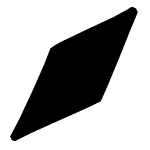Texte de l'exposition Germs, Musée Archéologique de Cracovie, août 2019
Yan Tomaszewski’s practices connect distant points on the map of scientific disciplines allowing a smooth flow between archaeology and astronomy – two domains devoted predominantly to staring in opposite directions. Archaeology literally delves deep into the ground, while astronomy looks up at the sky. Even so, both offer better insight into what is going on the Earth’s surface, throwing light on the genesis of phenomena presently occurring on it. In Tomaszewski’s projects the disciplines act as instruments of artistic speculation, handy appliances for ascertaining the conditioning of the current state of affairs. Whether the origin of life on Earth is the question (brought here by a comet as his sculptural installation Tchouri suggests) or – on a smaller scale – the layout of industrial cities, both can be elucidated by glancing deep down, or up into space. Just for the sake of intriguing speculation, a fanciful exercise, one may consider them to be determined (inspired) by a cosmic or subterranean order.
The Germs project provides the artist with a new field for exploration of much the same kind, and he does his search for links between the birth of a modern socialist city and ancient artefacts hidden deep in the ground. The dawn of the new city and the Combine coincides with their excavation. Materialisation of historical progress, a description likely to be given by communist ideologists to Nowa Huta, comes into contact with traces of the past pregnant with visual forms fit enough to serve as models for newly erected districts, streets, and squares.
Germs are first of all a series of small sculptures related to two, if not more, periods in the history of Nowa Huta. Uniformly black, they oscillate between scale models of specific buildings and abstract pieces of architectural provenance. The clay objects executed by the artist have been inspired by archaeological finds discovered on the grounds that were becoming Nowa Huta in the late 1940s and early 1950s. The vast terrain of the future investment – the city and the Combine – was turned into an archaeological dig drilling through consecutive layers of soil in search of information about the past of the region. Excavated vases and pots with complicated ornaments and only partly fathomed purpose are exhibits at the Nowa Huta branch of the Archaeological Museum. They were discovered along with remains of furnaces and hearths, uncovering a history of steel industry that went further back than one could have surmised. Searching through the museum collection, Tomaszewski explores analogies between the forms of amphoras, pots, or clay receptacles and large-scale building constructions in the Combine, or the urbanism of the city, singling out patterns – ornaments which are similar to it. Unexpectedly, history assumes a circular shape instead of progressing in a linear way; it simply takes another turn. The biggest investment of the Six-Year Plan may seem a breach with the past, but it is only so on the surface. By reaching deeper, like archaeologists who conducted their research before the Combine did, one can go deep enough to uncover a steel-related past as old as 1,600 years, or older. Industry is not new to this agricultural region, and its renewed invasion into this reality is, according to the artist, a reappearance of what should be well-known here, what kept reminding of itself by means of traces, and digs.
For Tomaszewski, Nowa Huta is not only a modern creation, but also an amalgam of diverse traditions deposited in the place over centuries like information encoded in DNA. Testifying to a past that goes a long way back they are like seeds, resting spores capable of germinating as well as adapting to whatever conditions are prevailing when they begin to replicate themselves, and to modify. Germs disclose a version of the past hidden in the earth, a probable scenario dating from ancient times. Remaining dormant in the form of traces, pieces of pottery, it lay buried under tones of soil, waiting to be dug out. Like seeds storing information about the future shape of the organism.
The next stage in history is happening before our very eyes. Decomposed, recultivated, and restored for the sake of the city and its residents for years, the territory of the Combine is going through a phase of regression now. A landscape of rising chimneys and furnaces, the most expressive symbols of the “old” industrial order, is slowly receding to make space for horizontal and level post-industrial cityscapes. Viewed from the Wanda Mound – an ancient structure in the Polish context – the remnants of the history that occurred less than 70 years ago are a harbinger of a new order whose scripts may still be entombed in the ground in one form or another. It is only future generations of archaeologists who will come to search the terrain before another grand project takes place here that are going to find out what remains of the post-industrial era. Tomaszewski’s sculptures acquire the status of artefacts, items originating in a previous era. Photographed against uniform backgrounds, conforming to cataloguing standards, they recount an industrial tale that seems to be over now. Placed side by side with exhibits from the Archaeological Museum, they appear to be an impression of the past, lost in a storeroom, which may surface again one day to stimulate another return of a version of the past.
